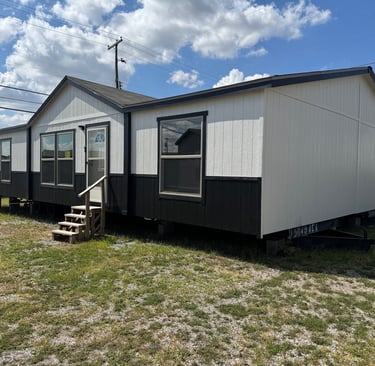Why First-Time Buyers Should Skip the Conventional Home Game and Go Prefab
Buying a house as a first time buyer and going prefab instead of conventional.
8/16/20255 min read


Buying your first home is supposed to be exciting. You finally stop paying rent to line someone else’s pockets and start putting your money into something that’s actually yours. But if you’ve started looking at conventional houses and the mortgages that come with them, you’ve probably already felt the reality check.
The 30-year mortgage. The endless list of documents. The hoops. The “just one more piece of paperwork” calls from the bank. The “your debt-to-income ratio is off by 0.1%, so… denied” emails.
For many first-time buyers, that experience is enough to make them throw in the towel and go back to renting. But here’s the thing: you don’t have to play by the big-bank, conventional-home rules.
There’s a smarter, faster, more flexible way to own a home — and it starts with going prefab.
Prefab Homes: The Underdog That’s Winning the Race
When people hear “prefab” or “manufactured home,” they often imagine something outdated — like a trailer from the 80s with thin walls and no curb appeal. But the prefab game has changed completely.
Modern prefab homes are stylish, customizable, energy-efficient, and built with quality materials that rival (and often exceed) those in conventional homes. The difference? They’re built in a controlled environment, shipped to your land, and assembled on-site — which cuts out a ton of inefficiencies and costs.
That means you get more house for less money and a much shorter wait time to move in.
But the real secret weapon of prefab isn’t just the cost — it’s the financing flexibility.
Why Private Bank Financing Beats the Big Banks
Let’s talk about the elephant in the room: big banks make buying a conventional home a nightmare.
When you apply for a standard mortgage through a traditional lender, you’re signing up for:
A 30-year commitment (which is basically a life sentence in financial terms).
Credit score obsession — if you had a hiccup years ago, you’re penalized.
Income proof from every angle — W-2s, tax returns, pay stubs, employment verification.
Endless back-and-forth — each request leads to another, and you feel like you’re in a never-ending scavenger hunt for documents.
Now compare that to buying a prefab home financed through a private bank:
15-year mortgages instead of 30 — you own your home outright in half the time.
Lower documentation requirements — in many cases, just three months of bank statements.
Faster approvals — no waiting weeks for underwriting to crawl through your life story.
More flexible credit guidelines — they’re looking at your ability to pay now, not punishing you for something that happened years ago.
For first-time buyers, this is a game-changer.
Why a 15-Year Mortgage is a Huge Win
Let’s do some quick math (don’t worry, I’ll keep it painless).
Say you’re buying a $150,000 prefab home. With a 30-year mortgage at a big bank, you’re paying it off until you’re gray-haired and sending your grandkids off to college. Over those three decades, the interest alone could add another $100,000+ to your total.
Now take that same home with a 15-year mortgage from a private bank. Your monthly payments might be a bit higher, sure — but you’re done in half the time. That means 15 years from now, while other people are still making payments, you own your home outright.
And the kicker? That frees up thousands of dollars per year you can invest, save, or use to upgrade your property.
Prefab Means Flexibility in More Than Just Financing
One of the biggest myths about homeownership is that it “ties you down” — as if the second you sign that mortgage, you’re trapped forever. Renters love to say, “Well, I can just move if I need to.”
Guess what? You can do the same with a prefab home.
You can sell it. You can move it (depending on the model). You can keep it as a rental property and buy another. The difference is that when you own, you’re in control of the move — not a landlord raising your rent or selling the property out from under you.
Lower Land Costs = More Freedom
Here’s another reason prefab is perfect for first-time buyers: you’re not locked into buying a house in a high-priced, overdeveloped neighborhood just to get a mortgage.
In places like Oklahoma, land prices outside city centers are surprisingly affordable. That means you can buy a piece of property for a fraction of the cost of a conventional lot and still be within a short drive of work, shopping, and entertainment.
And unlike renting an apartment, you’re getting space — land that’s yours to garden, build on, or just enjoy without a neighbor’s window staring back at you.
You Start With What You Need — And Build As You Go
One of the smartest moves for first-time buyers is starting with a home that meets your needs today, not overbuying for the “future you” five or ten years from now.
Prefab homes let you do that without sacrificing comfort or style. You can start with a smaller, more affordable model and add upgrades later when your budget allows. Try doing that with a conventional home — it’s a lot harder and a lot more expensive.
The Myth of “Better Resale Value” for Conventional Homes
Here’s the truth no big-bank realtor wants to admit: resale value is all about location, maintenance, and market conditions — not whether your home was prefab or stick-built.
If you take care of your prefab home and keep it modernized, it can hold value just as well as a conventional home. In fact, many buyers are now specifically searching for prefab options because they know they’re newer, more energy-efficient, and easier to maintain.
Less Maintenance, More Peace of Mind
Speaking of maintenance, here’s another plus: new prefab homes are built to modern codes and standards, which means you’re not buying a laundry list of hidden repairs like you might with an older conventional home.
For the first 5–7 years, your repair costs should be minimal — giving you more breathing room to enjoy your home instead of constantly fixing it.
Final Word: Prefab Isn’t the “Cheap” Option — It’s the Smart Option
For too long, prefab homes have been underestimated. But the numbers, the financing, and the lifestyle flexibility all point to one clear truth: for first-time buyers, prefab is the better play.
You’re not locked into a 30-year chain with a big bank breathing down your neck. You’re not drowning in paperwork for months. You’re not spending your first years of homeownership paying mostly interest while barely chipping away at the principal.
Instead, you get:
A home you can actually afford.
Financing that respects your time and reality.
Ownership in 15 years or less.
The ability to grow and adapt your property to your life — not the other way around.
So if you’re ready to stop playing by the old rules and start building your future on your own terms, skip the conventional home hunt. Go prefab, go private bank, and take control from day one.
